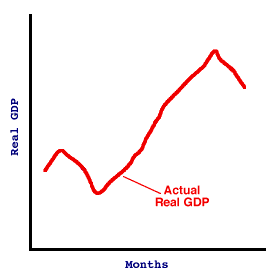
|
|
DECREASING-COST INDUSTRY: A perfectly competitive industry with a negatively-sloped long-run industry supply curve that results because expansion of the industry causes lower production cost and resource prices. For a decreasing-cost industry the entry of new firms, prompted by an increase in demand, causes the long-run average supply curve of each firm to shift downward, which decreases the minimum efficient scale of production.
Visit the GLOSS*arama
|
|


|

|
                           LONG-RUN TREND: The pattern of potential real gross domestic product of an economy based on full employment of available resources. The long-run trend is commonly represented as a positively-sloped line in a diagram depicting business-cycle phases. This slope captures the economy's expansion in its production possibilities resulting from increases in the quantity and quality of resources. The long-run trend is a positively-sloped line on a diagram that plots the movement of actual real gross domestic product over time. It is primarily used to identify unemployment and inflation problems generated by the business-cycle instability. If actual real gross domestic product is below the long-run trend, then the economy is not living up to its full employment potential and the economy has in a contraction and unemployment. If actual real gross domestic product is above the long-run trend due to an expansion, then the economy is temporarily overshooting its full employment potential, and inflation is likely to occur. | Long Run Growth | 
|
The diagram displayed in this exhibit can be used to illustrate the macroeconomy's long-run trend. The red line represents the value of real gross domestic product (real GDP) over a period of several months. Clearly real GDP rises, then falls, then rises, then falls. This is the instability, the ups and downs, that are a fundamental part of business cycles.To reveal the long-run trend of real GDP, or potential real GDP, click the [Long-Run Trend] button. This blue line represents the amount of real GDP that the economy can produce if all resources are fully employed, resulting in potential real GDP. It has a positive slope because the economy's production capabilities increase over time due to increases in the quantity and quality of resources. Historically, this long-run trend represents approximately a 3 percent annual growth of production capabilities and potential real GDP. Clearly actual real GDP does not follow this long-run trend of potential real GDP. During some periods actual real GDP is greater than potential real GDP and in other periods actual real GDP is less than potential real GDP, indicated by the red line lying above or below the blue line. During some periods actual real GDP is growing faster than potential real GDP, in other periods actual real GDP is growing slower than potential real GDP, indicated by the red line having a steeper or flatter slope than the blue line. And in some cases actual real GDP declines even though potential real GDP continues to expand. The fact that actual real GDP does not coincide with the long-run trend of potential real GDP is the essence of business cycles and instability of the macroeconomy.

Recommended Citation:LONG-RUN TREND, AmosWEB Encyclonomic WEB*pedia, http://www.AmosWEB.com, AmosWEB LLC, 2000-2025. [Accessed: July 18, 2025].
Check Out These Related Terms... | | | | | | | | | |
Or For A Little Background... | | | | |
And For Further Study... | | | | | | | | | | | | | |
Related Websites (Will Open in New Window)... | | | |
Search Again?
Back to the WEB*pedia
|



|

|
PURPLE SMARPHIN
[What's This?]
Today, you are likely to spend a great deal of time flipping through mail order catalogs trying to buy either a flower arrangement for your aunt or a birthday greeting card for your uncle. Be on the lookout for rusty deck screws.
Your Complete Scope
This isn't me! What am I?
|

|
|
Rosemary, long associated with remembrance, was worn as wreaths by students in ancient Greece during exams.
|

|
|
"A winner is someone who recognizes his God-given talents, works his tail off to develop them into skills, and uses those skills to accomplish his goals. " -- Larry Bird, basketball player
|

|
IER
International Economic Review
|

|
|
Tell us what you think about AmosWEB. Like what you see? Have suggestions for improvements? Let us know. Click the User Feedback link.
User Feedback
|


|


